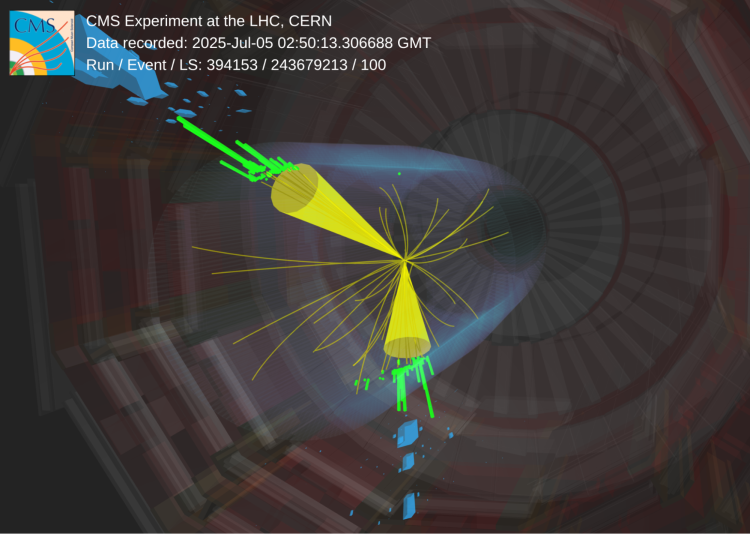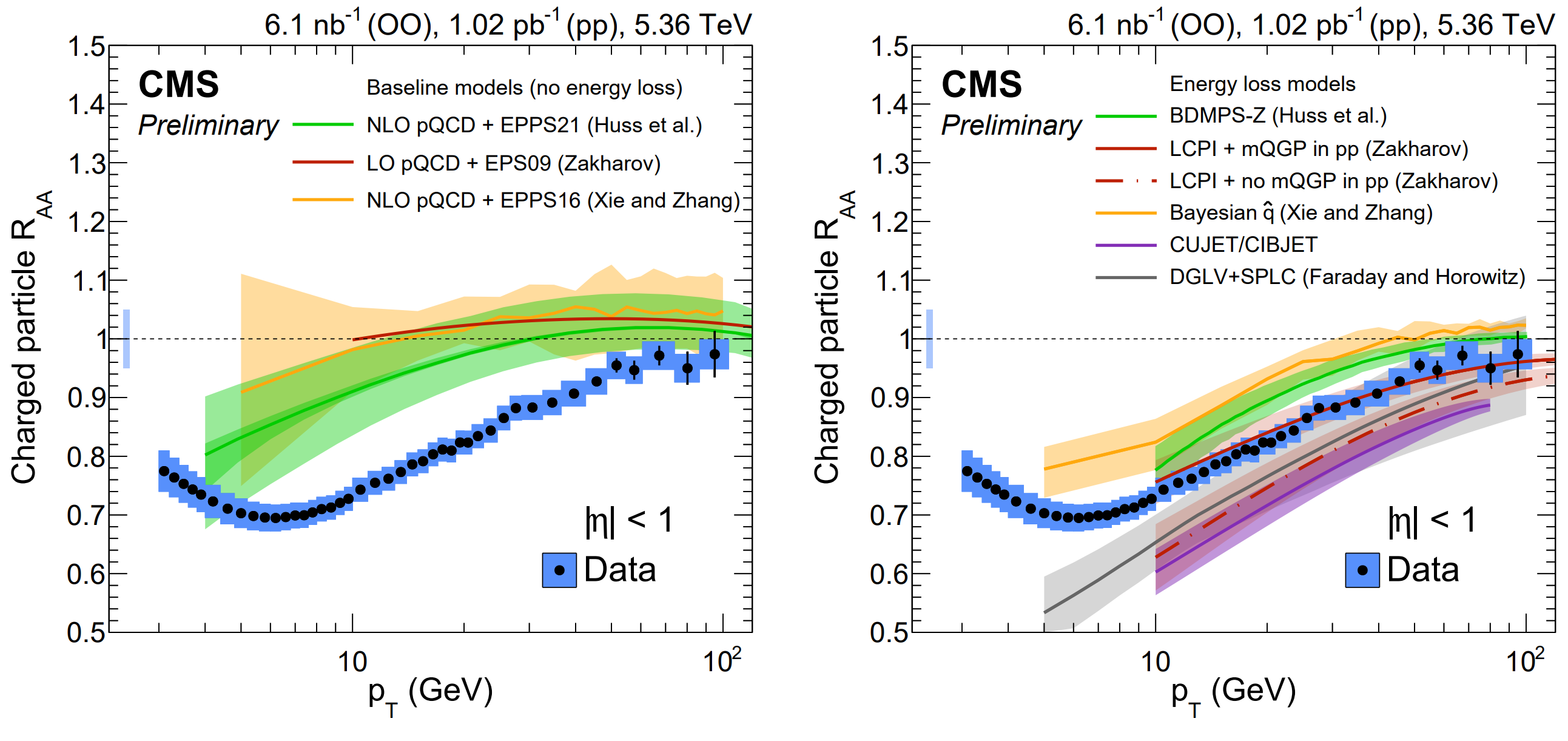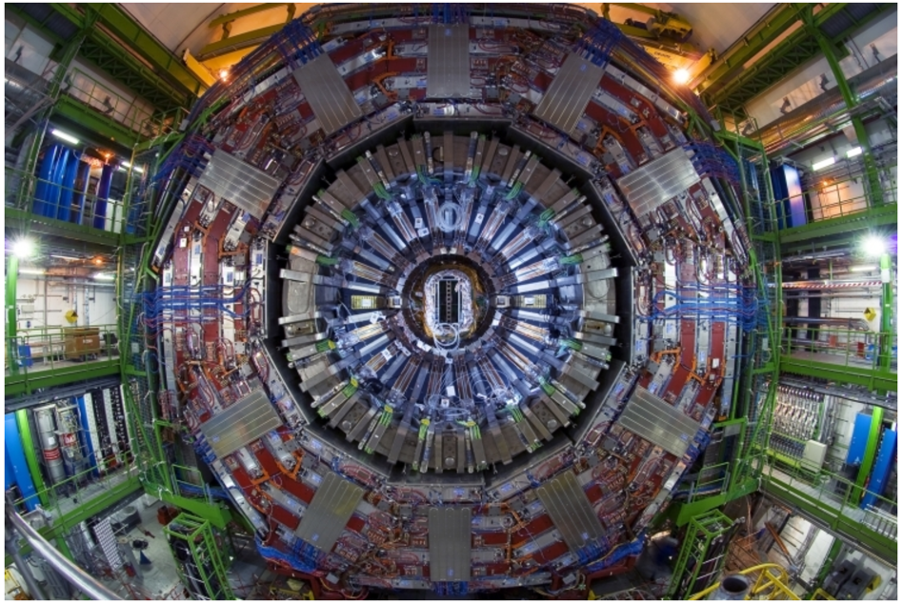
CMS scientists study the first-ever oxygen-oxygen collisions at the LHC, and observe signs of quarks and gluons losing energy when they travel through quark-gluon plasma – a state that existed just after the Big Bang.
When heavy ions such as lead (Pb) collide at nearly the speed of light inside the Large Hadron Collider (LHC), extreme conditions are created that can “melt” ordinary nuclear matter into a new state called the quark-gluon plasma (QGP). This hot and dense medium is believed to resemble the universe just microseconds after the Big Bang, when quarks and gluons – the fundamental building blocks of protons and neutrons – moved freely.
Physicists study the QGP medium by looking at how fast-moving quarks and gluons – collectively called partons – behave as they pass through it. Fast moving partons form sprays of particles, which can be seen as “jets” in particle detectors. In collisions of very small systems, such as proton-proton collisions, the observed jets are seen to retain the full energy or the original partons. In contrast, in heavy-ion collisions, the presence of the QGP medium leads to a significant loss of energy.
Why oxygen? Filling the gap between big and small systems
Until now, clear signs of energy loss had only been observed in collisions of very heavy nuclei, such as lead-lead (PbPb) or xenon-xenon (XeXe). On the other end of the spectrum, collisions involving small systems like proton-lead showed little or no energy loss, leaving an open question: how big does a system need to be to produce quark-gluon plasma?
This is where oxygen-oxygen (OO) collisions come in. Oxygen nuclei consist of eight protons and eight neutrons, making it an interesting candidate to test system size dependence of these effects. Oxygen-oxygen collisions probe the middle ground: they are larger than proton-lead events, where no quark-gluon plasma has been observed, but smaller than heavy-ion collisions, where the QGP is well established.
To explore the dynamics of these small systems, the LHC delivered its first-ever run of oxygen-oxygen collisions in July 2025, colliding oxygen ions at a center-of-mass energy of 5.36 TeV per nucleon pair. For the CMS experiment, this was a landmark opportunity to directly test QGP signatures in small systems. “Many people in the nuclear physics community have been waiting years for a chance to look at oxygen-oxygen collisions at LHC energies. The last few months have certainly been very exciting for all of us,” said Austin Baty, a physicist from the University of Illinois Chicago who had a leading role in the collection of these data.
The first measurement of oxygen-oxygen collisions at the LHC
Using 6.1 nb–1 of oxygen-oxygen collision data, together with 1 pb–1 of proton-proton events at the same energy, CMS measured charged-particle production over a wide range of transverse momentum. The figure below shows the nuclear modification factor which is defined as the ratio between charged particle yield in nucleus-nucleus collisions and a scaled baseline proton-proton yield, as a function of transverse momentum. The oxygen-oxygen results, shown as black points with blue boxes, reveal a clear trend: the ratio reaches a local minimum of about 0.65 at 6 GeV before rising toward unity at 100 GeV. “I was intrigued to see that even with such light nuclei we observe signs of QGP formation,” said Vipul Pant, a PhD student at the University of Illinois Chicago and one of the lead analyzers of the study.
Preliminary comparisons indicate that the data are more consistent with theoretical models that incorporate energy loss (right panel) than with those that omit it (left panel). “Our new results place crucial experimental constraints on the minimal conditions required to form a QGP droplet, helping address one of the most fundamental questions in our field,” said Gian Michele Innocenti, a physicist from the MIT’s Heavy-Ion Group, who – together with a large team of MIT students and postdoctoral researchers – played a central role in collecting and analyzing the data.

Above: The ratio between charged particle yield in nucleus-nucleus collisions and a scaled baseline proton-proton yield (RAA), as a function of transverse momentum (pT). CMS sees the oxygen-oxygen data lie below unity and have compared the measurement to theoretical models without parton energy loss (left) and with energy loss (right).
The new CMS results show a clear suppression of charged particle yield in oxygen-oxygen collisions and marks an important first step toward establishing a physics program dedicated to light-nucleus collisions at LHC energies.
Written by: Vipul Pant, for the CMS Collaboration
Edited by: Muhammad Ansar Iqbal
Read more about these results:
-
CMS Physics Analysis Summary (HIN-25-008): "Measurement of the charged particle nuclear modification factor in oxygen-oxygen collisions with CMS"
-
@CMSExperiment on social media: Bluesky - Facebook - Instagram - LinkedIn - TikTok - Twitter/X - YouTube

